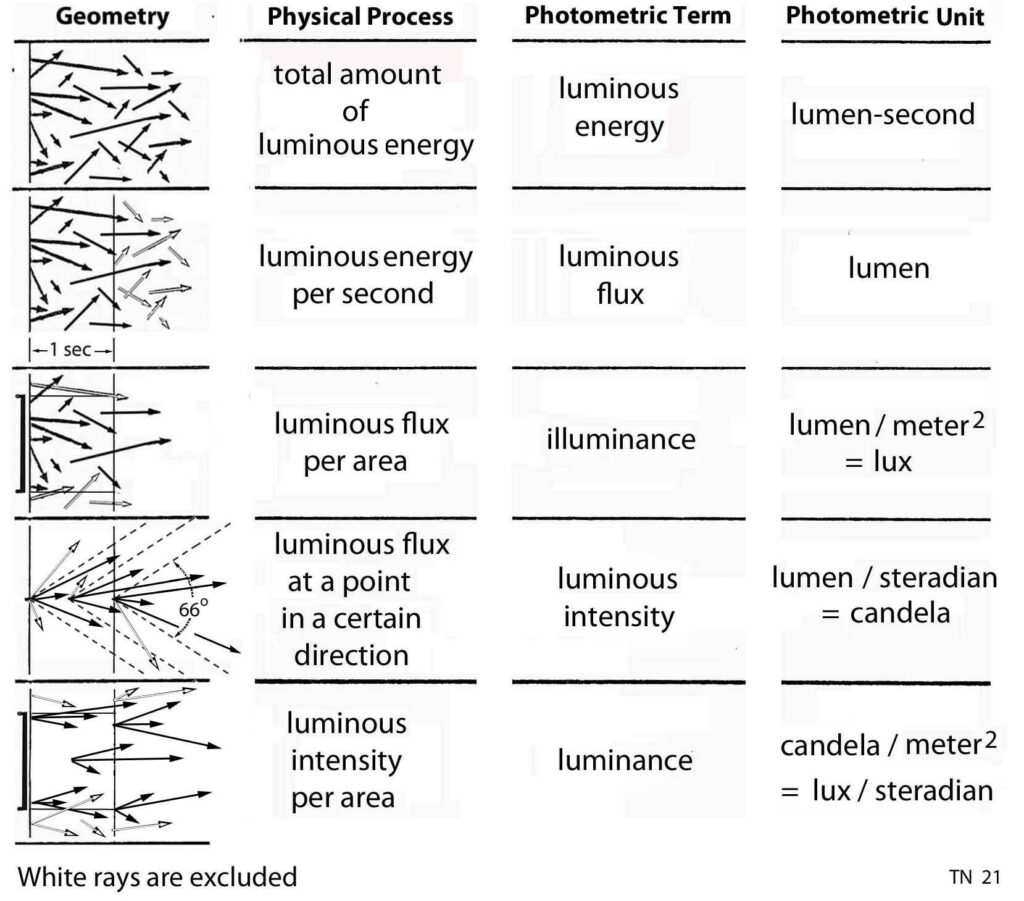Main Body
21 MEASURING LIGHT

The lumen replaces the radiometric watt in these units to indicate the rate at which light is emitted or received.As explained below, the basic unit of photometric measurement is actually the candela.
(On that basis the lumen would be replaced with candela- steradian. That’s not done to simplify matters and maintain similarity with the radiometric units.)
p. 80
While the watt is defined in terms of physical energy, doing so for its photometric equivalent, the lumen, is more complicated. Photometric measurements are based on a totally subjective effect – brightness. (Check back to Section 15 – Photons Vary in Visual Effectiveness, page 48.) Apart from correcting for visual sensitivity to various wavelengths, the experience of brightness involves a focused image in the eye of a beholder. That means a need to take into account that the energy is received from a certain direction.
The oldest system of measurement still in use is totally subjective: the stellar magnitude scale created by Hipparchus in 127 BC to describe the brightness of stars. It is still accurate because its standards, the brightness of certain stars, has not changed over thousands of years. Thus a star could be the standard for luminous intensity. (While calibrations would be restricted by weather, its universal availability compares favorably to the cost and exclusiveness of the present standard.)
In the 1700’s candles were used as brightness standards to enable measuring light by comparison. When candles were replaced by electric arc point sources emitting a similar number of watts/steradian at 555 nm, this quantity was named candela to reflect its history.
In 1979, the point source was replaced by a standard radiometer measurement of this amount of radiant intensity. In use it is aimed at a point source of light that is filtered across wavelength to match the CIE 1979 visual sensitivity function. When the radiometer reads 1.5*10-3 electromagnetic watts, the light from that source is1 candela of luminous intensity.
p. 81
Only two of the photometric measurements are widely used:
Illuminance measured in lux (lumen/meter 2)) is the amount of luminous flux arriving (or leaving) per unit area of a surface. This flux density determines the possible brightness of materials at that location depending also on their reflective characteristics. It is typically used to describe lighting conditions. However, it can also describe the effectiveness of light sources and reflecting surfaces in terms of how much light they emit per unit area.
Luminance measured in candela / square meter is the directional density of light emitted per unit area of a light emitting surface. Because it describes how light can be focused into an image, it is the measurement closest to physically describing brightness of light sources or reflecting surfaces. That’s because the same photometric measurement is equivalent to describing the directional density of light received per unit area of a light receiving surface.
When light is focused as an image sensed by discrete receptors, it may be useful to describe how much luminous flux is received per receptor. Whether a biological or technological, photo-receptors tend to respond at a rate proportional to the rate at which they receive light. This would seem closest to the basis of a “brightness” signal. That rate can be measured by multiplying the luminance measurement by the pupil area of the eye (its entrance pupil) and the visual field of a representative receptor.30
Yet there is still more to brightness than how many photons meet the eye and holistic processing. The observer’s state of light-dark adaptation, level of attention, and expectancy all influence the brightness experience.
